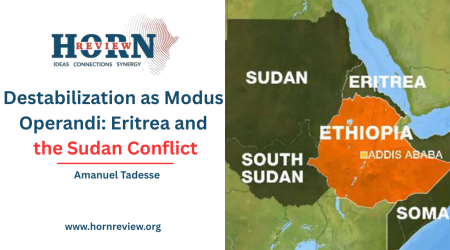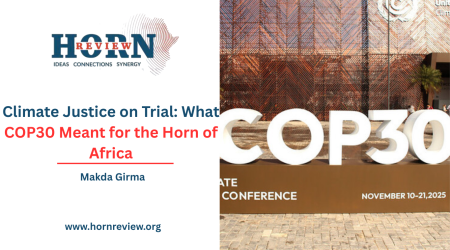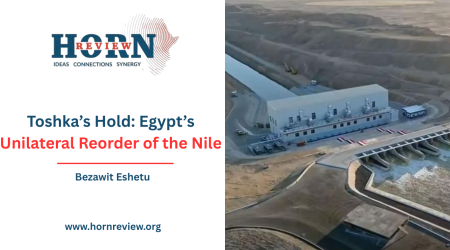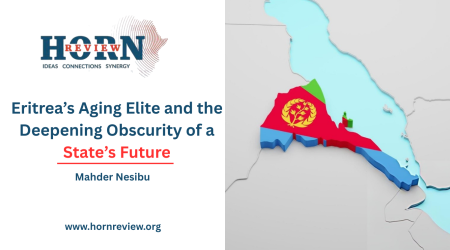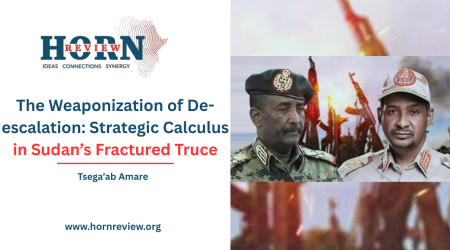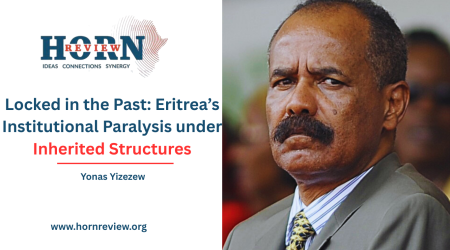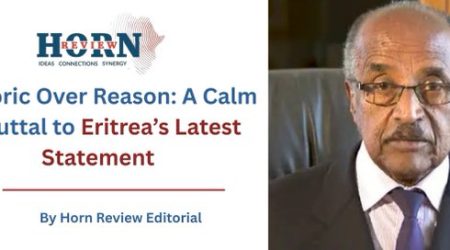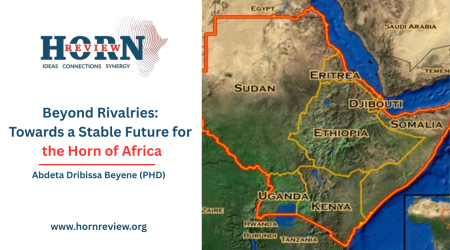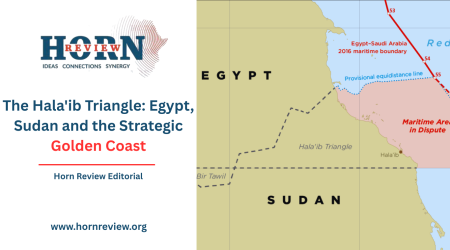
7
Apr
Omar Mahmood on Somalia: Al-Shabaab, Governance Struggles & Regional Diplomacy


Omar Mahmood, senior researcher on Somalia and the Horn of Africa at the International Crisis Group, sat down with Horn Review’s Jalene Tesfaye to discuss Somalia’s political and security landscape.

Horn Review: Thank you for being here, Omar. Given your extensive experience researching the region’s political and security dynamics, what are the most critical research areas that warrant deeper exploration? Additionally, considering the intricate political, security, and socio-economic challenges at play, what methodologies do you believe are most effective in capturing these dynamics and producing impactful analysis?
Omar Mahmood: Thank you for having me. One key area that warrants further exploration is reconciliation and the politics of grievance. The Horn of Africa faces significant tensions at both the community and national levels, with deep-rooted trust deficits stemming from historical and contemporary factors. These issues shape how communities are governed and interact with one another. The lack of trust between populations and governing systems often obstructs progress, even when certain initiatives make economic sense. Understanding these dynamics and identifying common themes across different contexts could help establish a stronger foundation for the region.
Another crucial area is governance frameworks. There are pressing questions about how governments in the region can effectively accommodate their diverse populations. Federalism remains a contentious issue in Ethiopia, Somalia, and South Sudan, raising broader questions about the best governance models for the region. Ensuring political stability while transitioning governments, such as in Ethiopia, Sudan, and potentially Djibouti and Eritrea, requires a more comprehensive understanding of governance structures.
Lastly, regional integration remains a largely untapped opportunity for prosperity. While economic benefits are often discussed, the political dimensions of integration need more attention. Understanding how political considerations shape regional cooperation could unlock new opportunities for the Horn of Africa.
In terms of methodologies, I find field research particularly valuable. While elite discussions in capital cities are important, they often fail to capture wider, localized perspectives. A more inclusive approach that incorporates grassroots insights would provide a more comprehensive understanding of the region’s challenges and opportunities.
Horn Review: Given the complex and often volatile politico-security landscape of the Horn of Africa, what do you see as the key factors driving instability in Somalia and the wider region? What practical strategies could be employed to navigate and address these persistent challenges?
Omar Mahmood: In my view, the primary driver of instability is political. Many of the tensions, conflicts, and developmental setbacks in the region can be traced back to unresolved political issues.
In Somalia, a fundamental lack of reconciliation has hindered state-building efforts. Rather than addressing these underlying grievances, there has been an attempt to construct a state on top of unresolved issues. The assumption was that a functioning state could eventually address reconciliation needs, but this approach has fallen short. Instead of tackling the deeper political challenges, the state-building process has often sought to bypass them.
Somalia’s political settlement remains fragile. Although the government shed its transitional label in 2012, it still operates in a transitional state. The ongoing constitutional review process highlights the unresolved foundational issues that continue to shape Somali politics. The country has achieved a basic political settlement at the elite level, but it lacks the depth needed for long-term stability. Meanwhile, deeper reconciliation efforts have not been sufficient to address the conflicts that have plagued Somalia since the government’s collapse in 1991.
The emphasis has been on rebuilding central governance structures, but without addressing the root causes of instability. Instead of focusing solely on state-building, Somalia needs a stronger peace-building agenda, one that prioritizes reconciliation over technical governance structures. A bottom-up approach, combined with a deeper elite-level political settlement, is essential for long-term stability.
This political deficit also impacts security. Al-Shabaab exploits governance weaknesses and unresolved grievances, while disputes over federalism and governance structures continue to fuel tensions. Addressing these political challenges is key to breaking the cycle of instability.
Horn Review: In your expert opinion, what are the most pressing challenges Somalia faces in its state-building process? How can domestic and international actors effectively address these challenges to ensure a more stable and functional state?
Omar Mahmood: The biggest challenge is the lack of deep political reconciliation. Somalia’s state-building process has often focused on creating institutions without fully addressing the grievances that underlie its political and social divisions. The country remains in a prolonged transition, with fundamental governance issues still unresolved.
Finalizing the constitution is critical. The fact that this process is still ongoing highlights unresolved disputes over power-sharing, governance models, and federalism. Addressing these issues through an inclusive dialogue will be essential for long-term stability.
Security remains a major concern, with Al-Shabaab continuing to exploit governance gaps. While military operations have had some success, they must be complemented by political solutions that address the root causes of insecurity. A comprehensive approach that combines security, governance reforms, and local engagement is needed.
The governance framework also requires clarity. Tensions between the federal government and federal member states (FMS) continue to hinder state-building efforts. Resolving these disputes through a well-defined power-sharing mechanism is essential.
External actors play a significant role, but their engagement must align with Somalia’s long-term stability goals rather than short-term political interests. International partners should support reconciliation efforts, regional diplomacy, and governance reforms that strengthen Somalia’s institutions.
Ultimately, Somalia needs a shift from a purely institutional state-building approach to a broader peace-building strategy, one that prioritizes reconciliation, political inclusion, and governance reforms. Addressing these foundational challenges is essential for ensuring a more stable and functional state.
Horn Review: You’ve touched on several aspects of Somalia’s governance and security challenges. In your view, what are the main agendas that have shaped Somalia’s trajectory over the past two decades?
Omar Mahmood: Much of this ties into what I’ve mentioned earlier, security and domestic fault lines ultimately stem from politics. If we look at Somalia over the past 20 years, I would identify three main agendas at play.
The first is state-building, the effort to rebuild the structures of governance after state collapse. This has led to the establishment of a federal government, federal member states, and, in some places, district-level administrations. While there has been progress, the approach has heavily prioritized the technical aspects of state-building over deeper reconciliation.
The second is counterterrorism, aimed at combating Al-Shabaab and preventing it from becoming a dominant force in Somalia or a threat beyond the region. This agenda often overlaps with state-building, as strengthening government institutions is seen as a way to weaken Al-Shabaab.
The third, and most overlooked, is peace-building. This aspect has received the least attention, yet it is the most crucial. Without addressing underlying grievances and fostering reconciliation, both state-building and counterterrorism efforts will continue to face setbacks. While it’s impossible to achieve perfect sequencing given Somalia’s dynamic landscape, peace-building needs to be prioritized alongside the other agendas.
Regarding international partners, their role should be to incentivize Somali-led initiatives rather than dictate the process. A decade ago, the UN and Western actors like the US and UK played a dominant role. That phase has now shifted, Somalia has a federal government in place, albeit still reliant on external support. International partners must reassess their approach, focusing on strategic incentives rather than direct intervention.
Additionally, new actors have emerged in Somalia, including regional and middle-power states, shifting the balance of influence. While diverse interests will always exist, minimum coordination among international partners is essential to ensure a coherent approach toward Somalia’s stability.
Horn Review: On a related note, how can the issue of Al-Shabaab and similar terror groups be effectively addressed? Do you see a path beyond military intervention, such as political engagement or socio-economic strategies, that could contribute to a lasting solution?
Omar Mahmood: Addressing Al-Shabaab requires a two-track approach: military and political. On the military side, it is clear that Al-Shabaab is a violent actor, and sustained pressure must be maintained to limit its operations. However, military action alone will not resolve the conflict. The idea that Somalia’s security challenges can be solved purely through force is flawed.
This is where the political track comes in. At some point, engagement with Al-Shabaab must take place. This means understanding their vision for Somalia and exploring whether there is a path for negotiation within the country’s political framework. This approach may seem contradictory, fighting while engaging, but it is a common feature in conflict resolution worldwide. Governments and insurgent groups often battle and negotiate simultaneously, shaping the trajectory of the conflict.
The key question is how Somalia envisions the end of this conflict. If the assumption is that military force alone will eliminate Al-Shabaab, then the strategy remains purely military. However, if a long-term political solution is considered necessary, preparations for engagement must begin now.
This process will be neither quick nor linear. There will be setbacks, and progress will take time. However, given that this war has persisted for 18 years with no clear resolution, failing to explore political solutions means losing valuable time. The Somali federal government still benefits from significant international backing and has an African Union-led mission supporting security. Using this window of opportunity to lay the groundwork for negotiations could prove crucial in shaping Somalia’s long-term stability.
Horn Review: How do you assess regional dynamics from Somalia’s security perspective? How do regional alliances, rivalries, and external influences shape Somalia’s security landscape, and how should the country navigate these complexities to enhance its stability?
Omar Mahmood: Somalia faces a fundamental challenge: it is both politically weak and internally fractured. This makes it vulnerable to external actors who exploit its divisions. When foreign powers don’t get what they want from Mogadishu, they turn to alternative power centers, whether in Somaliland, federal member states, or other political factions, undermining national cohesion. Unlike centralized states where diplomatic engagement is concentrated in the capital, Somalia’s fragmented political environment allows multiple entry points for external influence.
This lack of a unified front creates a need for international coordination around a common objective, achieving sustainable stability. Without at least minimal coordination, Somalia remains vulnerable to manipulation, and international efforts become counterproductive.
The evolving partner landscape has further complicated this dynamic. Middle powers have entered the Somali equation, bringing much-needed investment and infrastructure opportunities. However, they also arrive with pre-existing rivalries that sometimes shape their engagement in Somalia through a zero-sum lens. While these external actors aren’t necessarily creating divisions, they often exacerbate them, emboldening Somali politicians to adopt more maximalist positions as they compete for external backing.
Internally, Somalia is a highly nationalistic society, yet its political elites frequently seek external legitimacy and support to strengthen their domestic positions. This contradiction weakens Somalia’s ability to resist foreign interference and complicates efforts to resolve internal disputes on its own terms. A national dialogue is needed to reassert sovereignty over Somalia’s political processes, ensuring that domestic divisions are not further inflamed by external interests.
Horn Review: How should we assess the trajectory of external interventions in Somalia? What key lessons can be drawn to ensure future engagements are more effective and productive?
Omar Mahmood: The most critical issue is the lack of coordination among external actors. While Somalia must take the lead in defining its own strategic approach, it also needs a clear and consistent policy on external engagement. Too often, Somali actors move from one partnership to another without a long-term vision, resulting in fragmented and inconsistent engagement.
For two decades, Western involvement in Somalia has largely centered on state-building and counterterrorism. However, over time, engagement has shifted into autopilot mode, and we are now seeing a gradual drawdown of Western support. This marks a transition to a new phase of external involvement in Somalia, where emerging middle powers are filling the vacuum left by waning Western interest.
While these middle powers bring enthusiasm and economic investment, they also carry geopolitical baggage from their own rivalries. Somalia’s challenge is to engage productively with external partners while avoiding entanglement in external conflicts. The goal should be to maximize economic and security benefits from these relationships while keeping political interference to a minimum.
Horn Review: There is a persistent fear that Somalia’s security dilemma is shaped by strategic proxy confrontations. How significant is regional integration in addressing this challenge? Additionally, how do you assess Ethiopia’s regional integration efforts, particularly the trilateral initiative launched by Prime Minister Abiy Ahmed in 2018 between Ethiopia, Eritrea, and Somalia?
Omar Mahmood: The 2018 tripartite initiative was largely a leadership-driven pact, rather than an institutionally anchored framework. Ethiopia sought to engage Mogadishu directly, bypassing federal member states, while also bringing Eritrea into the fold. However, the initiative was deeply tied to individual leaders, particularly Somalia’s former president Mohamed Abdullahi Farmajo. Once leadership changed, the framework collapsed.
This underscores a key lesson: for regional agreements to endure, they must be institutionalized rather than leader-dependent. Stronger institutional ties ensure that relationships outlast political transitions and lead to more sustained cooperation.
Another important takeaway is the need for practical economic cooperation. One of the major talking points in 2018 was the development of Somali ports to serve Ethiopia’s landlocked economy. However, very little progress was made, leaving the issue unresolved. Today, we are witnessing a return to the same discussions, as Ethiopia once again seeks port access through Somalia.
This highlights another lesson: regional cooperation must translate into concrete economic gains. If agreements remain purely political without practical benefits, they risk being short-lived. The renewed Ethiopia-Somalia engagement, following the Ankara Declaration, appears to be progressing in a more technical and structured manner, which is a positive sign.
Horn Review: How do you assess the current developments between Ethiopia and Somalia? Do you see genuine political will from both sides for a mutually beneficial arrangement, or are there underlying challenges that could hinder sustainable cooperation?
Omar Mahmood: Ethiopia and Somalia’s bilateral relationship is currently strong, having improved significantly following Turkish mediation. There is visible diplomatic goodwill, with high-level visits between the two capitals. On the security front, Ethiopia has increased its support for Somalia’s fight against Al-Shabaab, including airstrikes in areas where its troops are not even stationed. There is also a renewed effort to finalize an agreement on Ethiopian port access through Somalia.
While the relationship is on an upward trajectory, significant challenges remain. The key question is: what can Somalia offer Ethiopia in terms of port access? Ethiopia’s concerns revolve around proximity to Ethiopian markets, infrastructure readiness, and security guarantees. Any agreement must factor in the logistical and economic feasibility of different port locations, and the selected port must have, or be able to develop, the necessary infrastructure to support Ethiopian trade. Ensuring a safe and stable corridor for Ethiopian trade is also essential.
Turkey’s involvement as an external mediator and facilitator may help keep negotiations on track, but this is only one piece of the puzzle.
Beyond bilateral issues, broader regional questions remain unresolved. Two key challenges must be addressed: Regional economic integration – How can Ethiopia’s landlocked economy be sustainably linked to Somali coastal areas? Without clear economic linkages, investment in Somali ports lacks long-term viability. And Somaliland’s political status – The issue of Somaliland’s recognition remains unresolved, creating uncertainty for regional actors and complicating Ethiopia’s maritime ambitions.
While Ethiopia-Somalia relations are currently stable, these deeper regional issues must be addressed to ensure sustainable progress. If left unresolved, they could resurface as sources of tension in the future.

